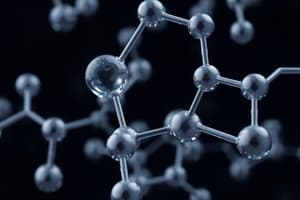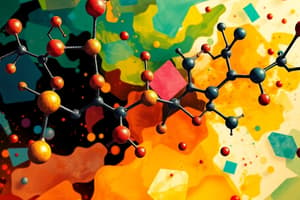Podcast
Questions and Answers
Which type of lipid is cholesterol categorized as?
Which type of lipid is cholesterol categorized as?
- Phospholipid
- Steroid (correct)
- Wax
- Triglyceride
Polysaccharides are made up of only one type of sugar molecule.
Polysaccharides are made up of only one type of sugar molecule.
False (B)
What is the main job of monosaccharides?
What is the main job of monosaccharides?
To provide a quick source of energy.
A chain of amino acids is called a ______.
A chain of amino acids is called a ______.
Match the common polysaccharides with their functions:
Match the common polysaccharides with their functions:
Which reaction connects amino acids together in proteins?
Which reaction connects amino acids together in proteins?
The structure of the protein does not affect its function.
The structure of the protein does not affect its function.
What are the monomers of carbohydrates?
What are the monomers of carbohydrates?
Cellulose is primarily found in ______.
Cellulose is primarily found in ______.
Which of the following describes the primary function of lipids?
Which of the following describes the primary function of lipids?
Flashcards
Carbon's Role in Life
Carbon's Role in Life
Carbon's unique ability to form four bonds with other atoms allows it to create the complex molecules essential for life, such as proteins, carbohydrates, and lipids.
Macromolecule Monomers
Macromolecule Monomers
The basic building blocks of macromolecules, such as amino acids for proteins, monosaccharides for carbohydrates, and fatty acids for lipids.
What are proteins?
What are proteins?
Large complex molecules made up of amino acid chains. They are essential for a wide range of biological functions, including structure, catalysis, and transport.
What's a polypeptide?
What's a polypeptide?
Signup and view all the flashcards
Sickle Cell Anemia
Sickle Cell Anemia
Signup and view all the flashcards
Carbohydrate Structure
Carbohydrate Structure
Signup and view all the flashcards
Lipid Function
Lipid Function
Signup and view all the flashcards
Cell Membrane Components
Cell Membrane Components
Signup and view all the flashcards
What are monosaccharides?
What are monosaccharides?
Signup and view all the flashcards
What are polysaccharides?
What are polysaccharides?
Signup and view all the flashcards
Study Notes
Carbon's Importance for Life
- Carbon's unique bonding properties allow it to form the complex structures essential for life on Earth.
- Carbon atoms form the backbone of many biological molecules, making them crucial for energy storage, genetic information, and structural support.
Macromolecule Composition
- Proteins: Composed primarily of carbon, hydrogen, oxygen, and nitrogen. May also contain sulfur.
- Carbohydrates: Composed primarily of carbon, hydrogen, and oxygen.
- Lipids: Primarily composed of carbon and hydrogen, with smaller amounts of oxygen.
- Nucleic Acids: Composed of carbon, hydrogen, oxygen, nitrogen, and phosphorus.
Macromolecule Structures
- Proteins: Chains of amino acids linked by peptide bonds. The specific sequence of amino acids determines a protein's unique three-dimensional shape. Complex shapes are crucial for function.
- Carbohydrates: Simple sugars (monosaccharides) can form linear or ring structures, and can link to form more complex sugars (disaccharides and polysaccharides). These structures vary greatly.
- Lipids: Generally composed of fatty acid chains and glycerol. Some lipids form ring structures (like cholesterol). Various shapes and sizes depending on the type of lipid.
- Nucleic Acids: Chains of nucleotides that form a double helix (DNA) or single strands (RNA).
Macromolecule Functions
- Proteins: A wide array of functions, including catalyzing reactions (enzymes), transporting molecules (hemoglobin), providing structural support (collagen), and coordinating cellular activities (hormones).
- Carbohydrates: Primary source of energy for the body. Also provide structural support, such as cellulose in plant cell walls.
- Lipids: Store energy, form cell membranes (phospholipids & cholesterol), and act as hormones & insulation.
- Nucleic Acids: Carry genetic information (DNA) and direct protein synthesis (RNA).
Types of Lipids
- Cholesterol: A type of steroid lipid.
- Phospholipids: Form the cell membrane bilayer.
- Triglycerides: Store energy.
Carbohydrate Classification
- Monosaccharides: Simple sugars (e.g., glucose, fructose, galactose). Single-unit sugars.
- Disaccharides: Formed by joining two monosaccharides (e.g., sucrose, lactose). Two-unit sugars.
- Polysaccharides: Formed by joining many monosaccharides (e.g., starch, cellulose, glycogen). Long chains of sugars. Visual differences in these structures are key to distinguishing them.
Protein Roles
- Structural components like collagen;
- Catalysts (enzymes) speeding up reactions;
- Hormones coordinating body functions;
- Transport proteins allowing movement of substances;
- Antibodies fighting off infection.
Macromolecule Monomers
- Proteins: Amino acids
- Carbohydrates: Monosaccharides
- Lipids: Glycerol & fatty acids
- Nucleic Acids: Nucleotides
Molecular Drawings (Phospholipid, Cholesterol, Glycerol, and Amino Acid chain)
- See a suitable diagram/illustration. (You can't create a drawing here).
Amino Acid Chains
- A chain of amino acids is called a polypeptide or protein.
Amino Acid Bonds
- Peptide bonds link amino acids together.
Amino Acid Bonding Ends
- The amino group (NH2) of one amino acid bonds to the carboxyl group (COOH) of another.
Sickle Cell Anemia Protein
- The protein hemoglobin is affected. A single amino acid substitution (valine for glutamic acid) alters the protein's shape and function.
Sickle Cell Anemia Cause & Effect
- The altered hemoglobin causes red blood cells to become rigid and sickle-shaped. This hinders oxygen transport because the abnormal shape reduces the cell's flexibility. Red bloods can't squeeze through capillaries effectively, reducing oxygen delivery to body's tissues.
Ring-like Macromolecule
- Lipids, specifically steroids like cholesterol, have ring-like structures. Some carbohydrates can form ring shapes as well.
Monosaccharide vs. Polysaccharide
- Structural Difference: Monosaccharides are single sugar units; polysaccharides are long chains of monosaccharides linked together.
- Functional Difference: Monosaccharides are direct energy sources; polysaccharides can store energy (starch, glycogen) or provide structural support (cellulose)
Monosaccharide Function
- Immediate energy source.
Polysaccharide Function
- Energy storage (starch, glycogen) and structural support (cellulose).
Common Examples
- Monosaccharides: Glucose, fructose, galactose
- Disaccharides: Sucrose, lactose, maltose
- Polysaccharides: Starch, cellulose, glycogen
Cellulose Function
- Provides structural support in plant cell walls.
Glycogen Function
- Stores glucose for energy in animals.
Lipid Function
- Main function is energy storage. Also critical for forming cell membranes.
Fatty Acid Types
- Saturated (all single bonds)
- Unsaturated (one or more double bonds)
Lipid Types
- Triglycerides
- Phospholipids
- Steroids
Cell Membrane Structure
- Fluid mosaic model. Phospholipid bilayer with embedded proteins and cholesterol.
- Protein Function: Transport molecules, act as receptors for signaling, and maintain cell structure.
- Cholesterol Function: Reinforces the membrane structure, maintaining its fluidity and preventing it from becoming overly rigid or too fluid.
Studying That Suits You
Use AI to generate personalized quizzes and flashcards to suit your learning preferences.




